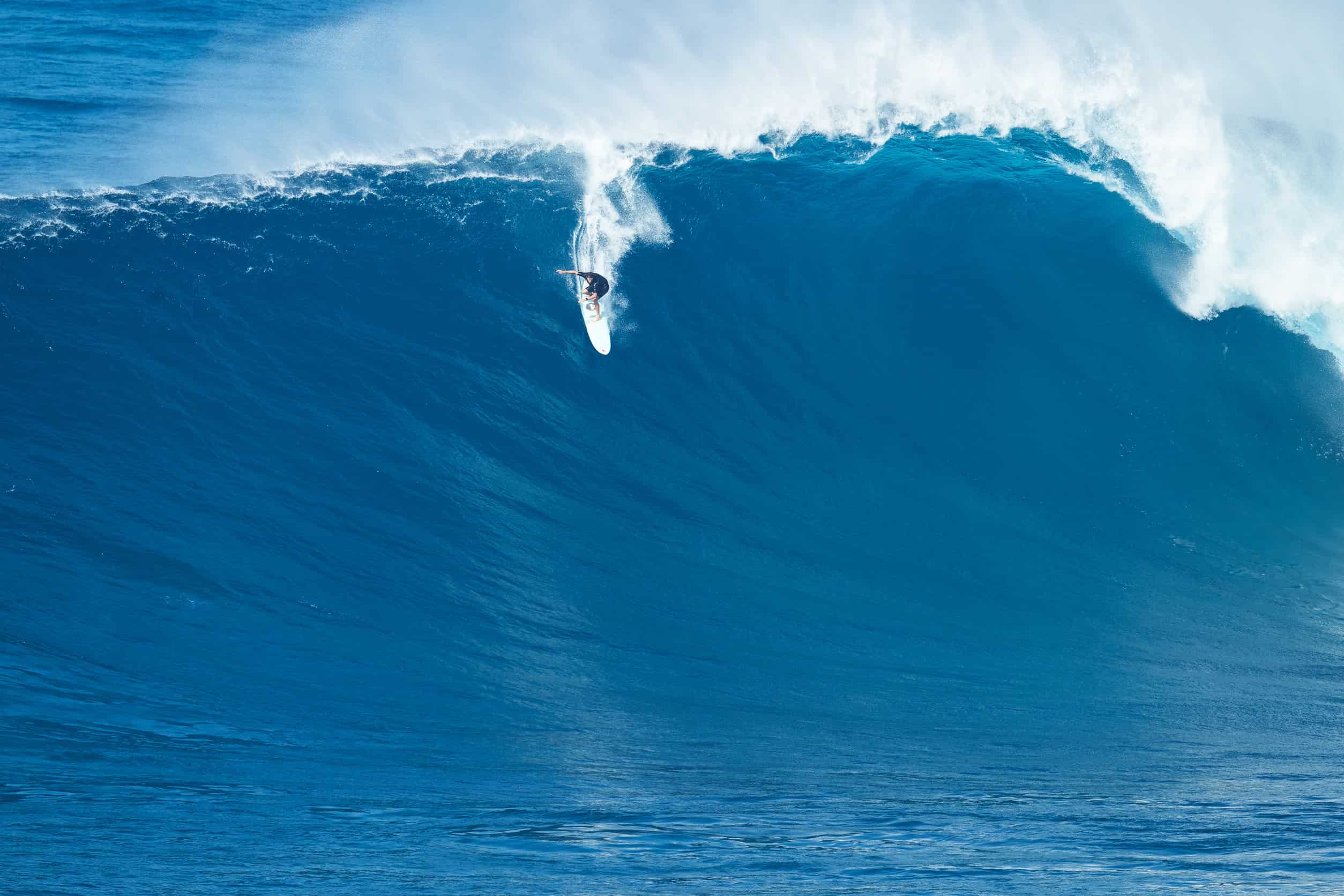Most of the thrill involved in surfing is due to the involved risks – make one mistake, and you’re falling off a rapid, 25 feet (7.62 meters) wave. Riding waves is an unmatched experience, but it’s not all fun and games. Wipeouts on a massive wave can be incredibly dangerous.
When big wave surfers fall, they may be hit by the wave’s lip and pulled deep underwater. They are often held there for several seconds. The body may feel as though it’s being squeezed from all of the pressure. Injuries are common, including lacerations, board injuries, and concussions.
In this article, we’ll discuss what it feels like to be in a big wave wipeout, what happens when surfers are held underwater, and what you should do if you’re ever in that situation. We’ll also touch on three types of wipeouts, common surfer injuries, and big wave surfer deaths. Read on to learn more.
What a Big Wave Wipeout Feels Like
If a surfer is riding a massive wave and the wave wipes them out, they may feel as though they’re free-falling from an enormous height. Once they hit the water, the lip of the wave may come crashing down upon them, causing immense pain and pressure. This pressure may also pull the surfer deep underwater.
The force of a massive wave is powerful. Physicists estimate that a big wave can apply up to 6,000 pounds of pressure per square foot (1,220.6 to 29,294.5 kg per square meter). The larger the wave, the heavier it is, which is precisely why big wave surfing is so dangerous.
As these huge waves crash over a surfer’s body, the body may feel as though it’s being squeezed due to loads of pressure. It’s an often violent experience, especially in large surf. Because of this force, the water may drive a surfer deep underwater – and it may happen very, very quickly.
Are Big Wave Surfers Held Underwater?
Big wave surfers can be held underwater due to the force of a massive wave. These “hold-downs,” as they’re called, may last for several seconds. In large surf, waves can keep a surfer underwater for ten seconds or more. A two-wave hold-down can hold a surfer under the water for up to 30 seconds.
While the surfer is underwater, their body is also being pulled toward the shoreline. The water is turbulent and may move their body about in different ways – twisting, tumbling, contorting. The moving water pulls and pushes the surfer around like a ragdoll.
If the surfboard is still attached, the board could cause injury if it hits the surfer. Additionally, the leash could snap, leaving a surfer disoriented with no leash to climb back to the surface. Even worse, a leash could become entangled in a surfer’s legs, preventing them from swimming. It goes without saying that being tangled in a surfboard leash is an extremely dangerous situation.
What Should You Do if You’re Held Under by a Big Wave?
If you’re held underwater by a big wave, protect your head with your arms. Stay calm and flexible because tensing up uses energy. Let the water move you. Eventually, you’ll rise to the top. If the force of the wave relaxes, swim to the surface, but be aware – another wave may not be far behind.
Fighting the waves can be detrimental. If you fight too much, you’ll use up energy and oxygen within the body’s tissue. You’ll subsequently end up tossed around even more, which could lead you to become disoriented. If you lose your sense of direction, you may end up swimming down instead of up, putting you in an even more dangerous situation.
Dangerous Types of Surfer Wipeouts
There are many types of surfer wipeouts, but these three are particularly dangerous.
Axe
Aptly named, an “axe” wipeout is when the wave’s lip (the most powerful part) directly hits the surfer. The impact often feels heavy, sharp, and painful, like an axe cutting through the body. This type of wipeout can cause serious injury. Many surfers refer to this type of wipeout as being “drilled” or “pummeled” by the waves.
Two-Wave Hold-Down
Two-wave hold-downs are common during extreme wipeouts in large, turbulent surf. It’s when a surfer is held underwater not by one but by two successive waves. When the water is excessively foamy and the waves are large, a surfer is more likely to experience a two-wave hold-down. These types of hold-downs are hazardous, as they make it difficult to swim to the surface.
Over the Falls
Perhaps one of the most dangerous wipeouts is an “Over the Falls” wipeout. The surfer is pulled back around and into the top of the wave. When the lip crests and falls, the surfer, too, falls with it. Because of the force of the wave as it crashes, it can easily push a surfer to the ocean floor. This can cause concussions or other fatal injuries.
Common Surfing Injuries
Injuries are common among surfers. According to a study published in the Journal of Sports Medicine and Physical Fitness, 29.6 percent of surfers suffered an injury within the last year.
within the last year.
While lacerations are some of the most prevalent injuries among surfers, other more serious injuries are common as well – and some are fatal:
- Head Trauma. A wipeout may cause a surfer to lose his board – and if it washes up near them, it can cause major injury. In addition, waves may push a surfer down with great force, slamming them into the ocean floor, causing a concussion. Even the force of the water crashing down on a surfer is enough to cause a head injury.
- Broken Ribs. Surfers can’t always predict how they’re going to fall when they wipe out. They can do their best to avoid an awkward position, but it’s not always possible to think so quickly. Being hit by their board, slammed against the seafloor, or pummeled against rocks can result in broken ribs (or other broken bones).
- Broken Eardrums. The inner ear is vital to the body’s balance. Naturally, it’s an essential part of surfing. However, wipeouts in large surf can cause damage to the inner ears. Not only is this injury excruciating, but it can prevent a surfer from ever hitting the waves again.
In addition to the above-mentioned injuries, drowning is yet another possibility. If a surfer wipes out on a massive wave, the water may hold them under for too long, they may end up unconscious after hitting their board or the seafloor, or they could find themselves tangled in their leash. Any of these situations may prevent a surfer from swimming to the surface, resulting in death by drowning.
How Many Big-Wave Surfers Have Died?
Approximately ten surfers die every year. Many big-wave surfers have died over the past three decades, including Mark Foo, Donnie Solomon, Todd Chesser, and Peter Davi.
every year. Many big-wave surfers have died over the past three decades, including Mark Foo, Donnie Solomon, Todd Chesser, and Peter Davi.
The hazards encountered during surfing are not to be taken lightly. Here are the names of several surfers that have died in surfing accidents since 1994.
- Mark Foo. Foo drowned after a seemingly harmless wipeout at Mavericks in Half Moon Bay in Northern California on December 23, 1994. It’s suspected that his board leash was tangled in the rocks, and a two-wave hold-down kept him below the surface.
- Donnie Solomon. On December 23, 1995, a year to the day that Mark Foo died at Mavericks, Donnie Solomon drowned
 at Waimea Bay in Hawaii. Waves swelled in excess of 20 feet (6.09 meters), and as he attempted to catch another, he was sucked over the falls and held underwater. A second wave approached, and Solomon drowned.
at Waimea Bay in Hawaii. Waves swelled in excess of 20 feet (6.09 meters), and as he attempted to catch another, he was sucked over the falls and held underwater. A second wave approached, and Solomon drowned. - Todd Chesser. At only 28-years-old, Todd Chesser headed to the North Shore of Oahu to surf Alligator Rock near Waimea Bay on February 13, 1997. It seemed like a great day for surfing until he was caught up in a large wave. Unable to make it to the surface, Chesser drowned.
- Peter Davi. Peter Davi headed out to Ghost Trees in Pebble Beach, California, on the morning of December 4, 2007. With waves rising up to 30 feet (9.14 meters), Davi ended up breaking his board leash and began heading to shore. He was offered a ride by two tow teams but refused. Later, his body was found in the water. The cause of death was listed as drowning, but he was also found with methamphetamine in his system.
- Sion Milosky. While surfing Mavericks on March 16, 2011, Sion Milosky wiped out. He didn’t have a leash, and he lost his board, making it difficult to swim to the surface. Milosky was subsequently held under by two waves
 . He never resurfaced. His body was found twenty minutes later.
. He never resurfaced. His body was found twenty minutes later. - Kirk Passmore. On November 12, 2013, Kirk Passmore went out to catch some waves in Alligator Rock. He was last seen riding a 20 feet (6.09 meters) wave and, after wiping out, witnesses reported he was swimming downward
 away from the surface. He is presumed dead, and it’s believed that he may have busted an eardrum or become disoriented, causing him to lose his sense of direction and subsequently drown.
away from the surface. He is presumed dead, and it’s believed that he may have busted an eardrum or become disoriented, causing him to lose his sense of direction and subsequently drown. - Alec Cooke. Also known as “Ace Cool,” Alec Cooke went surfing in the middle of the night in 2015 at Waimea Bay in Hawaii. Ace Cool was an experienced surfer, having been riding waves for three decades. That night, Cooke never returned home
 and is presumed to have drowned.
and is presumed to have drowned.
Conclusion
Falling is inevitable in any extreme sport. It is in the fall that surfers learn to maneuver better and control their bodies, allowing them to hone their skills. Unfortunately, falls are also what makes surfing so dangerous.
The ocean is relentless and unforgiving, far more powerful than any human being. Surfers must know how to handle themselves in dangerous situations so that they’re ready to catch the next big wave.

